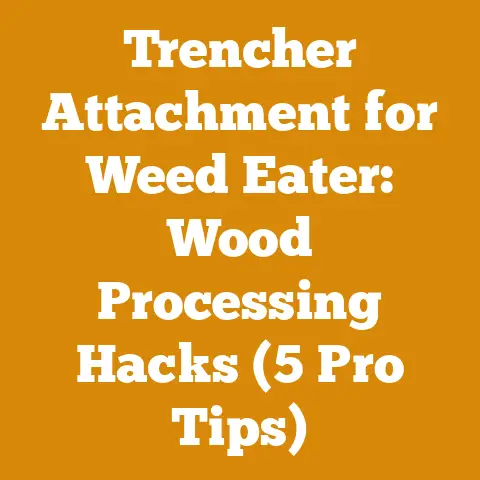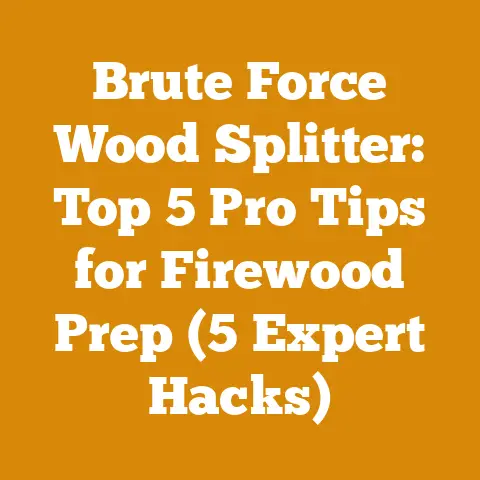How to Use a Wood Stove Damper (5 Pro Tips for Optimal Draft)
How to Use a Wood Stove Damper (5 Pro Tips for Optimal Draft)
The crackling warmth of a wood stove on a chilly evening is hard to beat. But getting the most out of your wood stove – and avoiding a smoky, inefficient mess – hinges on understanding and properly using the damper. I’ve spent years cutting, splitting, and burning firewood, and I’ve seen firsthand how a well-managed damper can transform a wood stove from a frustrating nuisance into a reliable source of heat. This article will delve into the intricacies of wood stove dampers, offering practical tips and insights to help you achieve optimal draft and efficient burning.
The Rising Cost of Warmth: Why Understanding Wood Stove Efficiency Matters
Let’s face it, the cost of heating our homes is constantly on the rise. Whether you’re relying on natural gas, electricity, or heating oil, the bills seem to climb higher each winter. This is why many homeowners are turning (or returning) to wood stoves as a supplemental or even primary heating source. However, simply installing a wood stove isn’t a guaranteed solution to lower heating costs. The key is efficient burning, and that’s where understanding your damper comes in.
I’ve noticed a significant trend: people are becoming more mindful of their wood consumption. They’re asking questions like, “Am I burning too much wood?” “Is my stove operating efficiently?” “How can I reduce creosote buildup?” The answer to all these questions often lies in mastering the art of damper control. In this article, I will share 5 pro tips to help you optimize your wood stove damper.
1. Understanding Your Damper: The Key to a Controlled Burn
The damper is essentially a valve within your wood stove’s flue or chimney. It controls the airflow, or “draft,” that moves air through the stove and up the chimney. Without a properly functioning damper, you’re at the mercy of the natural draft, which can be erratic and inefficient.
There are generally two types of dampers:
- Flue Damper: Located within the flue pipe, typically a butterfly-style damper that rotates to restrict or open airflow.
- Baffle Damper: Found above the firebox inside the stove itself, designed to create a longer, more efficient burn path.
Cost Considerations:
While dampers themselves are relatively inexpensive (ranging from $20 to $100 depending on type and quality), the potential cost savings from efficient burning are significant. A stove that burns efficiently uses less wood, reducing your fuel costs. Conversely, a poorly controlled damper can lead to excessive wood consumption and increased creosote buildup, which can necessitate costly chimney cleanings and even pose a fire hazard.
- Chimney Cleaning Costs: Average cost ranges from $150 to $300 per cleaning, depending on location and complexity.
- Wood Costs: The price of firewood varies widely. According to recent data from the U.S. Energy Information Administration (EIA), the average price per cord of firewood can range from $150 to $400, depending on the wood species, location, and supplier.
Personal Story: I once helped a neighbor who was struggling with a constantly smoking wood stove. After inspecting his setup, I discovered his flue damper was stuck in the fully open position. He was essentially sending all the heat straight up the chimney! By replacing the damper, he immediately noticed a difference in his stove’s efficiency and significantly reduced his wood consumption.
2. The Goldilocks Principle: Finding the “Just Right” Damper Setting
The most common mistake I see is people leaving the damper either fully open or fully closed. Neither of these extremes is ideal. A fully open damper allows too much air into the stove, causing the wood to burn too quickly and inefficiently. A fully closed damper, on the other hand, starves the fire of oxygen, leading to smoldering, smoke, and excessive creosote buildup.
The ideal damper setting is somewhere in between, allowing for a steady, controlled burn. The “Goldilocks Principle” applies here – you need to find the setting that’s “just right” for your stove, your wood, and the weather conditions.
Factors Affecting Damper Setting:
- Wood Species: Hardwoods like oak and maple require more air than softwoods like pine and fir.
- Wood Moisture Content: Drier wood burns more readily and requires less air.
- Chimney Draft: Stronger drafts require a more closed damper to prevent over-firing.
- Outdoor Temperature: Colder temperatures generally create a stronger draft.
- Stage of the Burn: A newly lit fire needs more air than a well-established fire.
How to Find the Sweet Spot:
- Start with the damper fully open when lighting the fire to establish a good draft.
- Once the fire is burning well, gradually close the damper until you see the flames become slightly less vigorous.
- Observe the smoke coming from the chimney. Ideally, you should see very little smoke, or a thin, wispy white smoke. Dark, heavy smoke indicates incomplete combustion and a need for more air.
- Monitor the stove temperature. Use a stove thermometer to ensure you’re not over-firing the stove. Aim for the manufacturer’s recommended temperature range.
- Adjust the damper as needed throughout the burn. As the fire burns down, you may need to slightly open the damper to maintain a good flame.
Data-Driven Approach:
Keeping a log of your damper settings, wood type, and stove temperature can help you identify the optimal settings for different conditions.
-
Example Log:
Date Wood Type Moisture Content Damper Setting Stove Temp (F) Notes 12/15/23 Oak 20% 50% Open 400 Good burn, minimal smoke 12/16/23 Pine 15% 75% Open 350 Burned too quickly, adjusted damper to 60% open for slower, more even burn 12/17/23 Oak 25% 40% Open 380 Slightly more smoke than usual, may need to dry wood further
Cost Impact: By fine-tuning your damper settings, you can reduce your wood consumption by as much as 20-30%, saving you hundreds of dollars per heating season.
3. The Importance of Seasoned Wood: Fueling Efficiency
No discussion about wood stove efficiency is complete without addressing the importance of seasoned wood. Seasoned wood is wood that has been allowed to dry for at least six months, preferably a year or more. This drying process reduces the moisture content of the wood, making it burn hotter, cleaner, and more efficiently.
Why Seasoned Wood Matters:
- Higher Heat Output: Wet wood wastes energy evaporating the moisture before it can burn, resulting in less heat for your home.
- Reduced Smoke and Creosote: Burning wet wood produces significantly more smoke and creosote, increasing the risk of chimney fires.
- Easier to Light: Seasoned wood ignites more easily and burns more readily.
Moisture Content:
The ideal moisture content for firewood is below 20%. You can measure the moisture content using a wood moisture meter, which typically costs between $20 and $50.
Cost Analysis:
Burning unseasoned wood is like throwing money up the chimney. You’ll need to burn significantly more wood to achieve the same level of heat, and you’ll be facing higher chimney cleaning costs due to increased creosote buildup.
- Example: Let’s say you typically burn 4 cords of seasoned wood per winter at $300 per cord, totaling $1200. If you burn unseasoned wood, you might need 5 or 6 cords to achieve the same level of heat, increasing your wood costs to $1500-$1800. Additionally, you’ll likely need to clean your chimney more frequently, adding another $150-$300 to your expenses.
My Experience: I once made the mistake of burning wood that I thought was seasoned but turned out to be still quite wet. The stove struggled to maintain a consistent temperature, produced excessive smoke, and I ended up using far more wood than usual. It was a costly lesson in the importance of proper seasoning.
Practical Tips for Seasoning Wood:
- Split the wood: Splitting wood exposes more surface area to the air, accelerating the drying process.
- Stack the wood properly: Stack the wood in a single row, allowing for good airflow around each piece.
- Elevate the wood: Use pallets or other materials to keep the wood off the ground.
- Cover the wood: Cover the top of the woodpile to protect it from rain and snow, but leave the sides open for ventilation.
- Allow ample time: Give the wood at least six months, and preferably a year or more, to dry properly.
4. Chimney Maintenance: Preventing Costly Problems
Your chimney is an integral part of your wood stove system, and proper maintenance is crucial for safety and efficiency. A clean, well-maintained chimney ensures proper draft, reduces the risk of chimney fires, and extends the life of your wood stove.
Creosote Buildup:
Creosote is a flammable byproduct of incomplete combustion that accumulates inside the chimney. It’s a leading cause of chimney fires. The rate of creosote buildup depends on factors like wood species, moisture content, and burning habits.
Inspection and Cleaning:
- Annual Inspection: Have your chimney inspected by a qualified professional at least once a year. The National Fire Protection Association (NFPA) recommends annual inspections.
- Cleaning Frequency: The frequency of chimney cleaning depends on your burning habits and the amount of creosote buildup. A good rule of thumb is to clean your chimney when creosote buildup exceeds 1/8 inch.
Cost of Chimney Maintenance:
- Inspection: $75-$150
- Cleaning: $150-$300
DIY Chimney Cleaning:
You can clean your chimney yourself using a chimney cleaning brush and rods. However, it’s important to follow safety precautions and ensure you have the proper equipment. Chimney cleaning brushes and rods typically cost between $50 and $150.
Cost Savings:
Regular chimney maintenance can prevent costly problems like chimney fires, which can cause extensive damage to your home and even endanger your life. The cost of repairing a chimney after a fire can range from hundreds to thousands of dollars.
My Experience: I once neglected to clean my chimney for too long, and I started noticing a strong odor of creosote and reduced draft. When I finally inspected the chimney, I found a thick layer of creosote buildup. It was a wake-up call to the importance of regular maintenance.
5. Mastering the Art of Draft Control: Optimizing Performance
Draft is the force that draws air into the wood stove and up the chimney. Proper draft is essential for efficient burning and preventing smoke from entering your home.
Factors Affecting Draft:
- Chimney Height: Taller chimneys generally create a stronger draft.
- Chimney Diameter: The chimney diameter should be appropriately sized for the wood stove.
- Outdoor Temperature: Colder temperatures generally create a stronger draft.
- Wind Conditions: Wind can affect draft, sometimes increasing it and sometimes decreasing it.
- Barometric Pressure: Low barometric pressure can reduce draft.
Troubleshooting Draft Problems:
- Weak Draft: If you’re having trouble getting the fire to start or if smoke is entering your home, you may have a weak draft. Possible causes include:
- Cold Chimney: A cold chimney can inhibit draft. Try warming the chimney by burning a small amount of paper or kindling at the base of the chimney before lighting the fire.
- Obstructions: Check for obstructions in the chimney, such as bird nests or debris.
- Damper Position: Ensure the damper is fully open when starting the fire.
- Air Leaks: Seal any air leaks around the stove or chimney to improve draft.
- Excessive Draft: If the fire is burning too quickly or you’re hearing a roaring sound in the chimney, you may have excessive draft. Possible solutions include:
- Closing the Damper: Gradually close the damper to reduce airflow.
- Installing a Barometric Damper: A barometric damper automatically adjusts to changes in draft, maintaining a consistent airflow.
Cost Considerations:
Addressing draft problems can involve a range of costs, from simple solutions like sealing air leaks to more complex solutions like installing a barometric damper or extending the chimney.
- Barometric Damper: $100-$300
- Chimney Extension: $500-$1500
My Experience: I once struggled with a persistent downdraft problem in my wood stove. After trying various solutions, I discovered that the chimney was too short and was being affected by wind currents. Extending the chimney by a few feet completely resolved the problem.
Advanced Techniques:
- Top-Down Burning: This technique involves lighting the fire from the top down, which can improve efficiency and reduce smoke.
- Air Injection Systems: Some wood stoves feature air injection systems that introduce preheated air into the firebox, promoting more complete combustion.
Conclusion: Mastering Your Damper for a Warmer, Cheaper Winter
Mastering the art of using your wood stove damper is essential for achieving optimal draft, efficient burning, and reducing your heating costs. By understanding the principles of damper control, using seasoned wood, maintaining your chimney, and troubleshooting draft problems, you can transform your wood stove into a reliable and cost-effective source of heat.
Remember, every wood stove and every home is different. It may take some experimentation to find the optimal damper settings for your specific situation. But with a little patience and attention to detail, you can unlock the full potential of your wood stove and enjoy a warmer, cheaper winter.
Actionable Takeaways:
- Inspect your damper: Ensure it’s functioning properly and not stuck or damaged.
- Experiment with damper settings: Find the “sweet spot” for your stove and wood type.
- Use seasoned wood: Aim for a moisture content below 20%.
- Maintain your chimney: Schedule regular inspections and cleanings.
- Troubleshoot draft problems: Identify and address any issues that may be affecting your stove’s performance.
By implementing these tips, you can not only save money on your heating bills but also enjoy a safer and more enjoyable wood-burning experience. So, go ahead, stoke that fire, adjust that damper, and bask in the warmth of a well-managed wood stove!






